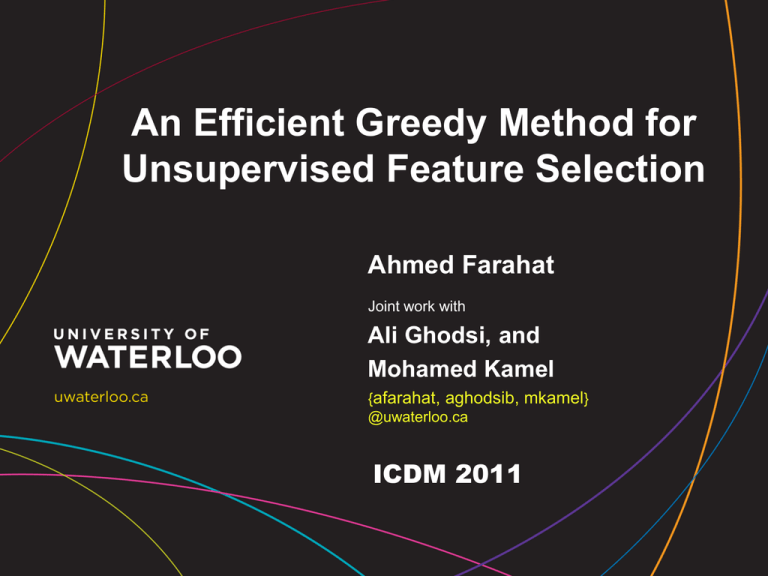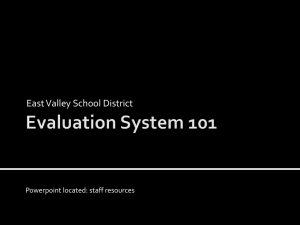
An Efficient Greedy Method for
Unsupervised Feature Selection
Ahmed Farahat
Joint work with
Ali Ghodsi, and
Mohamed Kamel
{afarahat, aghodsib, mkamel}
@uwaterloo.ca
ICDM 2011
2
Outline
• Introduction
– Dimension Reduction & Feature Selection
– Previous Work
• Proposed Work
– Feature Selection Criterion
– Recursive Formula
– Greedy Feature Selection
• Experiments and Results
• Conclusion
3
Dimension Reduction
• In data mining applications, data instances are
typically described by a huge number of features.
– Images (>2 megapixels)
– Documents (>10K words)
• Most of these features are irrelevant or redundant.
• Goal: Reduce the dimensionality of the data:
– allow a better understanding of data
– improve the performance of other learning tasks
4
Feature Selection vs. Extraction
• Feature Selection (a.k.a variable selection)
searches for a relevant subset of existing features
(−) a combinatorial optimization problem
(+) features are easy to interpret
• Feature Extraction (a.k.a feature transformation)
learns a new set of features
(+) unique solutions in polynomial time
(−) features are difficult to interpret
5
Feature Selection
• Wrapper vs. filter methods:
– Wrapper methods search for features which enhance the
performance of the learning task
(+) more accurate, (−) more complex
– Filter methods analyze the intrinsic properties of the data, and
select highly-ranked features according to some criterion.
(+) less complex, (−) less accurate
• Supervised vs. unsupervised methods
• This work: filter and unsupervised methods
6
Previous Work
• PCA-based
calculate PCA, associate features with principal components based
on their coefficients, select features associated with the first
principal components (Jolliffe, 2002)
• Sparse PCA-based
calculate sparse PCA (Zou et al. 2006), select for each principal
component the subset of features with non-zero coefficients
• Convex Principal Feature Selection (CPFS)
(Masaeli et al
SDM’10)
formulates a continuous optimization problem which minimizes the
reconstruction error of the data matrix with sparsity constraints
7
Previous Work (Cont.)
• Feature Selection using Feature Similarity (FSFS)
(Mitra et al.
TPAMI’02)
groups features into clusters and then selects a representative
feature for each cluster
• Laplacian Score (LS) (He et al. NIPS’06)
selects features that preserve similarities between data instances
• Multi-Cluster Feature Selection (MCFS) (Cai et al. KDD’10)
selects features that preserve the multi-cluster structure of the data
8
This Work
• A criterion for unsupervised feature selection
– minimizes the reconstruction error of the data matrix based on
the selected subset of features
• A recursive formula for calculating the criterion
S
P
• An effective greedy algorithm for unsupervised feature
selection
9
Feature Select Criterion
Data matrix
n
features
Reconstructed matrix
Minimize loss
m
instances
Least squares
10
Feature Select Criterion
(Cont.)
Problem 1: (Unsupervised Feature Selection) Find a
subset of features
such that
where
and
This is an NP-hard combinatorial optimization problem.
11
Recursive Selection Criterion
Theorem 1: Given a set of features
. For any
,
S
where
P
12
Recursive Selection Criterion
Lemma 1: Given a set of features
where
. For any
(Cont.)
,
13
Proof of Lemma 1
14
Proof of Lemma 1
• Let
(Cont.)
be the Schur complement of
in .
• Use block-wise inversion formula of
:
15
Recursive Selection Criterion
• Corollary 1: Given a set of features
(Cont.)
. For any
,
• Proof:
– Using Lemma 1,
0
16
Recursive Selection Criterion
Theorem 1: Given a set of features
where
. For any
,
17
Proof of Theorem 1
18
Greedy Selection Criterion
• Problem 2: (Greedy Feature Selection) At iteration t,
find feature l such that,
• Using Theorem 1:
where
• Problem 2 is equivalent to:
19
Greedy Selection Criterion
(Cont.)
20
Greedy Selection Criterion
• At iteration t:
• Problems:
– Memory inefficient:
– Computationally complex:
per iteration
(Cont.)
21
Greedy Selection Criterion
• At iteration t, define:
• Calculate E and G recursively as:
• ,
• Define
,
(Cont.)
22
Memory-Efficient Selection
Update formulas for f and g
23
Partition-based Selection
• Greedy selection criterion:
+
per iteration
• At each iteration, n candidate features x n projections
• Solution:
– Partition features into c << n random groups
– Select the feature which best represents the centroids of these
groups
– Similar update formulas can be developed for f and g
– Complexity:
+
per iteration
24
25
Experiments
Seven methods were compared
• PCA-LRG: is a PCA-based method that selects features associated
with the first k principal components (Masaeli et al 2010)
• FSFS: is the Feature Selection using Feature Similarity (Mitra et al. 2006)
• LS: is the Laplacian Score (LS) method (He et al. 2006)
• SPEC: is the spectral feature selection method (Zhao et al. 2007)
• MCFS: is the Multi-Cluster Feature Selection method (Cai et al. 2010)
• GreedyFS: is the basic greedy algorithm (using recursive update
formulas for f and g but without random partitioning)
• PartGreedyFS: is the partition-based greedy algorithm
26
Data Sets
•
These data sets were recently used by Cai et al. (2010) to evaluate
different feature selection methods in comparison to the Multi-Cluster
Feature Selection (MCFS) method.
27
Results – k-means
28
Results – Affinity Propagation
29
Results – Run Times
30
Results – Run Times
31
Conclusion
• This work presents a novel
unsupervised feature selection.
greedy
algorithm
for
– a feature selection criterion which measures the reconstruction
error of the data matrix based on the subset of selected features
– a recursive formula for calculating the feature selection criterion
– an efficient greedy algorithm for feature selection, and two
memory and time efficient variants
• It has been empirically shown that the proposed algorithm
– achieves better clustering performance
– is less computationally demanding than methods that give
comparable clustering performance
Thank you!
32
33
References
•
•
•
•
•
•
•
•
I. Jolliffe, Principal Component Analysis, 2nd ed. Springer, 2002
H. Zou, T. Hastie, and R. Tibshirani, “Sparse principal component analysis,” J.
Comput. Graph. Stat., 2006
M. Masaeli, Y. Yan, Y. Cui, G. Fung, and J. Dy, “Convex principal feature
selection,” SIAM SDM 2010
X. He, D. Cai, and P. Niyogi, “Laplacian score for feature selection,” NIPS 2006
Y. Cui and J. Dy, “Orthogonal principal feature selection,” in the Sparse
Optimization and Variable Selection Workshop, ICML 2008
Z. Zhao and H. Liu, “Spectral feature selection for supervised and unsupervised
learning,” ICML 2007
D. Cai, C. Zhang, and X. He, “Unsupervised feature selection for multi-cluster
data,” KDD 2010
P. Mitra, C. Murthy, and S. Pal, “Unsupervised feature selection using feature
similarity,” IEEE Trans. Pattern Anal. Mach. Intell., 2002.









